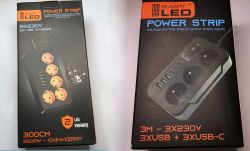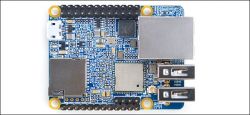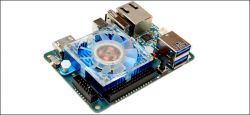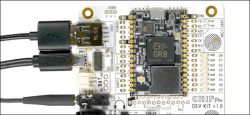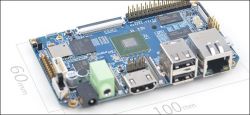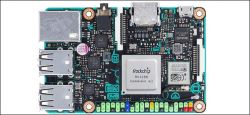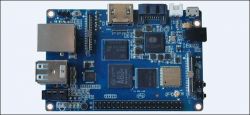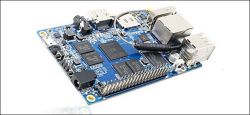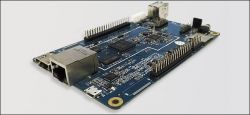The Raspberry Pi single board computer is a small and inexpensive computer system based on an integrated system-on-chip that has become very famous in the circles of amateurs and hobbyists. Thanks to the tremendous success of this design, numerous companies have followed suit and created their own alternatives to the popular 'Raspberry'. All these systems have their own characteristics and everyone will be able to choose an alternative that is right for them.
Currently, there is a lot to choose from on the market. In addition to the machines listed below, there are many more single-board mini-computers, but our focus is on the same segment as the Raspberry Pi, at least in terms of price and size - a dimension below the Mini-ITX size and a price point of less than a hundred dollars.
NanoPi Neo Plus 2 ($ 30)
The NanoPi Neo Plus 2 computer uses the Allwinner A53 chip. It's a quad-core ARM processor with one gigabyte of RAM. The module has a built-in network card - wireless (Wi-Fi) and wired, as well as Bluetooth. The module has integrated 8 GB of semiconductor mass memory, a slot for a microSD card and two USB 2.0 ports.
The module is not equipped with an HDMI connector or an audio output, such as the Raspberry Pi 3, but on the other hand, the board is half the size of its competitor, which makes it an inexpensive and miniature alternative to the RPi.
The system comes with a pre-installed operating system - UbuntuCore.
ODroid Xu4 ($ 60)
Xu4 is the latest version of the well-known ODroid single board computer. This system was designed and built from scratch to install Android on it. The device has an integrated Samsung octa-core processor. This chip may be twice as expensive as the new Raspberry Pi, but at the same time has twice as much RAM, as well as audio and micro-HDMI ports. You can use a microSD card to store data on this computer.
Due to the built-in large fan and quite a large size of the computer, it is not an ideal choice for integration in tight spaces and small devices. However, when it comes to Android PCs, there's basically no better option than this platform.
CHIP Pro Dev Kit ($ 50)
The CHIP Pro computer is more of a competition to the Raspberry Pi Zero, mainly due to its very small size for easy integration into other systems. The computer has a single-core ARM processor clocked at 1 GHz, up to 512 MB of RAM and modules for communication via Wi-Fi and Bluetooth.
You can buy the entire development kit for the computer. It gives access to USB or a standard headphone jack, and in the set itself we get a normal CHIP module for integration in the system, when we create our application.
This system is ideal for applications where the compact size of the computer is important.
NanoPC-T3 ($ 59)
FriendlyElec's Nano series of single board computers is one of the most popular alternatives to the Raspberry Pi, mainly due to its rich feature portfolio. The NanoPC-T3 model is equipped with a Samsung octa-core processor with passive cooling and 1 GB of RAM.
The module is equipped with an Ethernet port, a module for wireless communication (Wi-Fi and Bluetooth), an SD card slot and 8 GB of built-in memory. Audio and video signals can be found in the full size HDMI (1080p) socket. The computer is also equipped with a headphone jack, built-in microphone, four USB ports with the possibility of expansion through the connector.
The only drawback of this computer is that it requires a power supply from 5V, but not from USB. The module is also slightly larger than the Raspberry Pi. FriendlyElec, apart from the single-board computers themselves, provides various expansion modules compatible with T3.
ASUS Tinker Board ($ 60)
ASUS is one of the largest computer manufacturers in the world. So it's no surprise that the company wanted to expand its influence to hobbyist computers. They were successful in getting to the market by offering the very powerful Tinker Board single board computer.
The latest version of Tinker Board includes a quad-core processor from RockChip, clocked at 1.8 GHz. The computer has a whopping 2 GB of RAM, significantly more than most machines on this list. In the package we also get a standard Ethernet / Wi-Fi / Bluetooth kit, a microSD card connector and four USB 2.0 posts.
The computer comes preinstalled with TinkerOS - an open platform built on top of the Debian distribution.
B anana Pi M3 ($ 82)
The Banana Pi series of single board computers is part of a group that is trying to directly compete with the Raspberry Pi, also by name. The M3 model is a very strong machine. The system is equipped with an octa-core processor with ARM A7 cores and 2 GB of RAM. Of course, the system includes both an Ethernet connector and a module for communication via Wi-Fi. When it comes to data storage, the Banana Pi M3 offers us the possibility of placing a microSD card in the system or connecting a hard drive with a SATA port. This port is an important distinguishing feature of Banana Pi, because it allows you to connect typical hard drives to this computer - such as to its larger counterparts. In addition, the system includes an HDMI connector, a headphone jack and, unfortunately, only two USB ports.
Orange Pi Plus 2E ($ 50)
Orange Pi is another single-board computer from the "fruit" group. It tries to compete with RPi, but also offers its own solutions, such as integrated 16 GB Flash memory.
The system has as much as 2 GB of RAM and a quad-core processor clocked at 1.3 GHz. The system has two USB 2.0 ports, an infrared port and a Wi-Fi module with the possibility of connecting an external antenna. The only thing that hurts is the lack of dedicated power systems in the board at this price.
Pine A64 ($ 15 to $ 29)
The Pine A64 computer is dedicated to industrial applications, but that does not mean that it does not work well in hobby or amateur applications. Modules are offered in various versions of equipment, from 512 MB RAM up to 2 GB RAM. All of them feature a 1.2 GHz quad-core processor.
Pine A64 is equipped with an Ethernet connector, microSD card slot, HDMI output. The cheapest models do not have Wi-Fi and Bluetooth, but they can still find many interesting applications in amateur projects.
Source: https://www.howtogeek.com/330966/eight-alternatives-to-the-raspberry-pi/
Currently, there is a lot to choose from on the market. In addition to the machines listed below, there are many more single-board mini-computers, but our focus is on the same segment as the Raspberry Pi, at least in terms of price and size - a dimension below the Mini-ITX size and a price point of less than a hundred dollars.
NanoPi Neo Plus 2 ($ 30)
The NanoPi Neo Plus 2 computer uses the Allwinner A53 chip. It's a quad-core ARM processor with one gigabyte of RAM. The module has a built-in network card - wireless (Wi-Fi) and wired, as well as Bluetooth. The module has integrated 8 GB of semiconductor mass memory, a slot for a microSD card and two USB 2.0 ports.
The module is not equipped with an HDMI connector or an audio output, such as the Raspberry Pi 3, but on the other hand, the board is half the size of its competitor, which makes it an inexpensive and miniature alternative to the RPi.
The system comes with a pre-installed operating system - UbuntuCore.
ODroid Xu4 ($ 60)
Xu4 is the latest version of the well-known ODroid single board computer. This system was designed and built from scratch to install Android on it. The device has an integrated Samsung octa-core processor. This chip may be twice as expensive as the new Raspberry Pi, but at the same time has twice as much RAM, as well as audio and micro-HDMI ports. You can use a microSD card to store data on this computer.
Due to the built-in large fan and quite a large size of the computer, it is not an ideal choice for integration in tight spaces and small devices. However, when it comes to Android PCs, there's basically no better option than this platform.
CHIP Pro Dev Kit ($ 50)
The CHIP Pro computer is more of a competition to the Raspberry Pi Zero, mainly due to its very small size for easy integration into other systems. The computer has a single-core ARM processor clocked at 1 GHz, up to 512 MB of RAM and modules for communication via Wi-Fi and Bluetooth.
You can buy the entire development kit for the computer. It gives access to USB or a standard headphone jack, and in the set itself we get a normal CHIP module for integration in the system, when we create our application.
This system is ideal for applications where the compact size of the computer is important.
NanoPC-T3 ($ 59)
FriendlyElec's Nano series of single board computers is one of the most popular alternatives to the Raspberry Pi, mainly due to its rich feature portfolio. The NanoPC-T3 model is equipped with a Samsung octa-core processor with passive cooling and 1 GB of RAM.
The module is equipped with an Ethernet port, a module for wireless communication (Wi-Fi and Bluetooth), an SD card slot and 8 GB of built-in memory. Audio and video signals can be found in the full size HDMI (1080p) socket. The computer is also equipped with a headphone jack, built-in microphone, four USB ports with the possibility of expansion through the connector.
The only drawback of this computer is that it requires a power supply from 5V, but not from USB. The module is also slightly larger than the Raspberry Pi. FriendlyElec, apart from the single-board computers themselves, provides various expansion modules compatible with T3.
ASUS Tinker Board ($ 60)
ASUS is one of the largest computer manufacturers in the world. So it's no surprise that the company wanted to expand its influence to hobbyist computers. They were successful in getting to the market by offering the very powerful Tinker Board single board computer.
The latest version of Tinker Board includes a quad-core processor from RockChip, clocked at 1.8 GHz. The computer has a whopping 2 GB of RAM, significantly more than most machines on this list. In the package we also get a standard Ethernet / Wi-Fi / Bluetooth kit, a microSD card connector and four USB 2.0 posts.
The computer comes preinstalled with TinkerOS - an open platform built on top of the Debian distribution.
B anana Pi M3 ($ 82)
The Banana Pi series of single board computers is part of a group that is trying to directly compete with the Raspberry Pi, also by name. The M3 model is a very strong machine. The system is equipped with an octa-core processor with ARM A7 cores and 2 GB of RAM. Of course, the system includes both an Ethernet connector and a module for communication via Wi-Fi. When it comes to data storage, the Banana Pi M3 offers us the possibility of placing a microSD card in the system or connecting a hard drive with a SATA port. This port is an important distinguishing feature of Banana Pi, because it allows you to connect typical hard drives to this computer - such as to its larger counterparts. In addition, the system includes an HDMI connector, a headphone jack and, unfortunately, only two USB ports.
Orange Pi Plus 2E ($ 50)
Orange Pi is another single-board computer from the "fruit" group. It tries to compete with RPi, but also offers its own solutions, such as integrated 16 GB Flash memory.
The system has as much as 2 GB of RAM and a quad-core processor clocked at 1.3 GHz. The system has two USB 2.0 ports, an infrared port and a Wi-Fi module with the possibility of connecting an external antenna. The only thing that hurts is the lack of dedicated power systems in the board at this price.
Pine A64 ($ 15 to $ 29)
The Pine A64 computer is dedicated to industrial applications, but that does not mean that it does not work well in hobby or amateur applications. Modules are offered in various versions of equipment, from 512 MB RAM up to 2 GB RAM. All of them feature a 1.2 GHz quad-core processor.
Pine A64 is equipped with an Ethernet connector, microSD card slot, HDMI output. The cheapest models do not have Wi-Fi and Bluetooth, but they can still find many interesting applications in amateur projects.
Source: https://www.howtogeek.com/330966/eight-alternatives-to-the-raspberry-pi/
Cool? Ranking DIY





